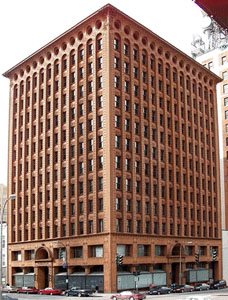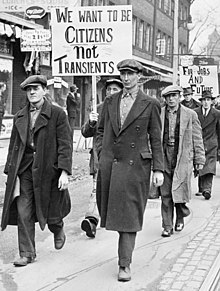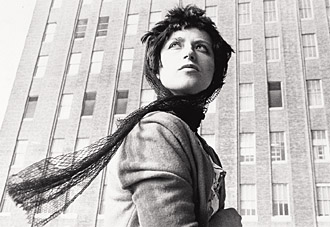- the city in modernism
- possibility of an urban sociology
Georg Simmel (1858-1918)
- German sociologist
Dresden Exhibition (1903)
- Simmel asked to lecture on role of intellectual life in city but instead reverses idea and writes about the effect of city on individual
- experience of how to negotiate people and environment
- Herbert Bayer, Lonely Metropolitan 1932
- influence of Surrealism and Freud
- subject and his surroundings
Urban sociology
- Lewis Hine (1932)- relationship of body to city, in-balance, risk to bodies in the construction of city
- investigation
- Georg Simmel, The Metropolis and Metal Life 1903
- resistance of individual to being levelled, swallowed up in the social-technological mechanismArchitect Louis Sullivan (1856-1924)
- form follows function
- creator of modern skyscraper
- influential architect and critic of the Chicago school
- mentor to Frank Lloyd Wright
- Guaranty building - stills resides in arts and crafts movement, organic decoration influenced by this, as works develops idea of form follows function is applied to layout of building
- different zones in the building that are reflective of the organisation of the body, dictates how person would move through space when using the building
Carson Pirie Scott store in Chicago (1904)
- skyscrapers represent the upwardly mobile city of business opportunity
- fire cleared buildings in Chicago in 1871 and made way for Louis Sullivan new aspirational buildings
- "upwardly mobile-ness" of city, part of the American dream, everything is up for grabs, what attracts people to the city
Manhatta (1921) Paul Strand and Charles Scheeler
- Charles Scheeler
- artist, photographer
- works for Ford company
- Ford Motor Company's plant at River Rouge, Detroit (1927)
- typical of modernist aesthetic
- represent industrial site in a very abstract manner
- celebration of shape and forms of industry
- arrangement of forms in space influenced by abstract art of the time
Fordism: mechanised labour relations
- coined by Antonio Gramsci in essay "Americanism and Fordism"
- body becomes part of machinery in factor
- "eponymous manufacturing system designed to spew our standardised, low-cost goods and afford its workers decent enough wages to buy them" (De Grazia: 2005:4)
- cycle of production and consumption
- not just about workers producing the goods, but affordable goods being produced and bought by the workers themselves
- repetitive cycle, carry on working to afford products you are producing yourself
Modern Times (1936) Charlie Chaplin
- comedy
- writes and directs film and stars as factory worker employed on assembly line
- struggles with being part of machine, goes haywire and causes havoc
- ends up being trapped inside machine
- making a comment on this aspect of modernity, coming at it from a critical point of view - body being swallowed by machine
- comical but political
Stock market crash of 1929
- factories close and unemployment goes up dramatically
- difficult social situations but expansion and explosion in industry
- leads to "the Great Depression"
- Margaret Bourke-White
Man with a Movie Camera (1929)
- double exposure
- fast motion, slow motion, freeze frame
- making a comment on Russian society
- Stalin-era, 1929
- looking at ideal society, figure on the street, whether or not we're reaching those ideals in reality
Flaneur
- term flaneur comes from French masculine noun flaneur which means strollers, lounger, saunterer, lounger
- upper class gentlemen, has to have time to stroll around city making comments
- idleness put forward as creativity
Charles Baudelaire
- proposes version of flaneur - that of a person who walks the city in order to experience it
- art should capture this
- simultaneously apart from and a part of the crowd
- sitting back and observing social interaction
Walter Benjamin
- adopts the concept of urban observer as an analytical tool and as a lifestyle as seen in his writing
- Arcades Project 1927-40, final incomplete book about Parisian city life in 19th century
- Berlin Chronicle/Berlin Childhood (memoirs)
- critique of modernity and experiences of it
- thinking about experience of strolling through arcades with mother and observing cafe society
- people start to think about how city is used by people and how it might be arranged to maximise the experience
- arcade = experience the city but you're protected from the elements, outside and inside at the same time, encourages you to purchase things, weather doesn't stop your consumerist desires
Photographer as flaneur
- Susan Sontag on photography
- photographer is an armed version of solitary walker reconnoitring, stalking, cruising urban inferno, voyeuristic stroller who discovers city as a landscape of voluptuous extremes. Adept of the joys of watching, connoisseur of empathy, the flaneur finds the world 'picturesque'
- photographer is looking for beautiful moments in urban environment, individual or architectural
- early modern street photography
Flaneuse
- invisible flaneuse
- women and the literature of modernity
- Janet Wolff
- Theory, Culture and Society November 1985 vol. 2 no. 3 37-46
- figure of flaneur is male because women in modernism didn't have same freedom to walk around and do this
- central figure of the flaneur in the literature of modernity can only be male
Susan Buck-Morss
- The Dialects of Seeing: Walter Benjamin and the Arcades
- only figure of a woman on the street can be is either prostitute or a bag lady
Arbus/Hopper
- Woman at a Counter Smoking, NYC (1962)
- Automat (1927) - woman isolated, dwarfed by environment
- sense of dread
- event that's almost anticipated
- in between moment
- up to us to invent/place the story
Sophie Calle Suite Venitienne (1980)
- following a man on streets of Venice
- series of black and white photographs plus diary style entries that map moves like a detective
- includes reflections on behaviours
- turns into a love story on the verge of a stalking relationship
Venice
- city as a labyrinth of streets and alleyways in which you can get lost but at the same time will always end up back where you begin
- inevitably going to come across a person who is followed
- Don't Look Now (1973) Nicholas Roeg
The Detective (1980)
- wants to provide photographic evidence of existence
Cindy Sherman Untitled Film Stilles (1977-80)
- snapshot moments of isolated figure in urban environment
- narrative but difficult to pin down
- era implied by clothing
- not sure where we are in time or space, reference to the past in the styling
- film noir scénario
- still shot at base of World Trade Centre - don't look like the world trade centre unless you knew the towers well, wasn't trying to make photos of Manhattan, wanted them to be mysterious and unidentifiable
- point of images is you project your experience into those and identify with them because of anonymity
Here is New York book/exhibition
- response to attacks of September 11th
- record of photographic images made up of professionals and ordinary people that were there at the time
- democracy of photographs
- 3,000 photographs but archive itself is much bigger
- democratise image making
- one image identical to Cindy Sherman image, 2001/1977, illustration, is it art imitating life or the other way round, suggestion of female experience of the city, uncomfortable female experience
Weegee (Arthur Felig)
- 30s and 40s
- press photographer in lower Easter of NYC
- signature style = always appeared at an emergency or a murder
- believe he's somehow in touch with spirits, but in reality he was the only photographer with a short wave police radio and that's how he managed to get to the scene of time
- developed photographs in dark room in back of his car
The Naked City
- collection of Arthur Felig's work
- developed into tv series in 50s and 60s
- closing tag line
- 8 million stories
- film noir, documentary style with voice over
- mysterious female figure, typical plot
LA Noire (2011)
- first video game to be shown at Tribecca Film Festival
- 1947
- investigation of crime scenes
Cities of the future/past - Fritz Lang Metropolis (1929)
- depicts futuristic city
Ridley Scott - Bladerunner (1982/2019), LA
- strange mixture, typical of post-modernism
- styling of film is very retro
- film noir with 1980s edge
Lorca di Corcia, Heads (2001) NY
- investigation of public and private through representation of the bodies
- illuminates random subjects
- has a trip wire synched with flash of camera
- no acknowledgement of process
- subjects don't know they're being photographed
- comment on experience of city and idea that you're alone in a crowd in a city full of lots of people but at the same time you don't know your neighbours or talk to people
- repeat of expressions in Sherman's work
- representations of interior life
- what's going on in our heads fixed with the outer experience
Public/Private
- lawsuit, crossing line between public and private
- Jewish gentleman brings him to court, rejects image on religious grounds, violation of privacy and religious rights, shouldn't be published without his consent
- judge dismisses lawsuit and says di Crocia can use these images
- protection of art is not limited to only starving artists, a profit motive in itself does not necessarily compel a conclusion that are has been used for trade purposes
- man doesn't have a say over the use of his own image
Walker Evans, Many Are Called (1938)
- travelling around on tube, photographing with concealed camera
- underneath his trench coat
- seen as a really interesting exposure of interior city life
- people who are unaware, lost in thought
- haunting quality
- together in adversity but separate in an interior sense
Postmodern city
- micro world, difficult to get out
- experience of moving through an architectural space relating it back to post modernism
Joel Meyerowitz, Broadway and West 46th Street NY 1976
- bombardment of information
- intense saturated colour
- depth of field so we don't have a focus
- group of people but no one is the subject of the image, no one is prioritised
- figures take up less than bottom half of image
- elevated view point
- replicates experience of being in city and having disorientation
9/11 Citizen journalism: the end of the flaneur?
- destruction of american dream
- Adam Bezer 2011, fall of twin towers, image taken on mobile phone
- democratisation of the process of image making
- Liz Wells, immediacy of mobile phone images which recorded the event as commuters travel to work
- images online within an hour
Surveillance City
- Wells: 09: 339
- enormous ramping up of investment in machine reading technologies
- seek machines to look at pictures on our behalf
Untitled, 2003, Runa Islam
- nominated for Turner Prize 2008
- not available online
- uses BBC news footage of collapse of World Trade Centre, slows it down and puts it in reverse
- fantasy moment of reversed time, tragedy is undone
- simple, almost child-look







_01.jpg)



























No comments:
Post a Comment